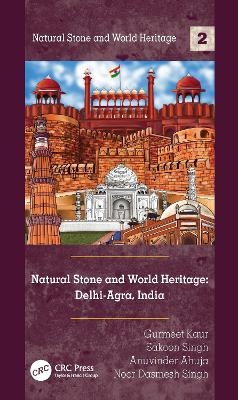
Natural Stone and World Heritage: Delhi-Agra, India
Seiten
2020
CRC Press (Verlag)
978-0-367-25180-2 (ISBN)
CRC Press (Verlag)
978-0-367-25180-2 (ISBN)
This book discusses heritage stones which were used in the making of the architectonic heritage of Delhi and Agra, encompassing UNESCO world heritage sites and heritage sites designated as prominent by the Indian government. The most famous monument of the two cities is the ‘Taj Mahal’ of Agra.
The book focuses on the geological characteristics of the famous Makrana marble, red sandstone and other sandstone variants of the Vindhyan basin and Delhi quartzite, the most widely used stones in almost all the monuments, as well as on their quarries. The work also aims to sensitise the public to protecting and preserving the architectonic heritage of these two densely populated cities in India as repositories of our past cultures and traditions. Identifying the nature and provenance of stones/rocks used in construction will lead to better restoration for future generations, in light of the deterioration of architectonic heritage through various natural weathering agencies and anthropogenic activities.
The book will serve as a useful source book to economic geologists, geologists, archaeologists, architects, historians and stone industry operators specifically and to academic and non-academic communities, travellers and tourism industry operators in general. The book will benefit students, researchers, and rock enthusiasts spanning all age groups and academic levels.
The book focuses on the geological characteristics of the famous Makrana marble, red sandstone and other sandstone variants of the Vindhyan basin and Delhi quartzite, the most widely used stones in almost all the monuments, as well as on their quarries. The work also aims to sensitise the public to protecting and preserving the architectonic heritage of these two densely populated cities in India as repositories of our past cultures and traditions. Identifying the nature and provenance of stones/rocks used in construction will lead to better restoration for future generations, in light of the deterioration of architectonic heritage through various natural weathering agencies and anthropogenic activities.
The book will serve as a useful source book to economic geologists, geologists, archaeologists, architects, historians and stone industry operators specifically and to academic and non-academic communities, travellers and tourism industry operators in general. The book will benefit students, researchers, and rock enthusiasts spanning all age groups and academic levels.
Gurmeet Kaur, Sakoon Singh, Anuvinder Ahuja, Noor Singh
1. UNESCO World Heritage Sites, International Union of Geological Sciences and Heritage Stone Subcommission. 2. Delhi and Agra vis-à-vis monuments. 3. Repository of Stones used in Delhi and Agra UNESCO Sites: Aravalli Mountain Belt and Vindhyan Basin. 4. UNESCO World Heritage sites of Delhi and Agra: An Account. 5. Historical quarries of the Makrana Marble, the Vindhyan sandstone and the Delhi quartzite vis-à-vis functional quarries. 6. Preservation, Conservation and Restoration of UNESCO World Heritage Sites of Delhi and Agra. 7. Conclusions.
| Erscheinungsdatum | 04.06.2020 |
|---|---|
| Reihe/Serie | Natural Stone and World Heritage |
| Verlagsort | London |
| Sprache | englisch |
| Maße | 138 x 216 mm |
| Gewicht | 408 g |
| Themenwelt | Kunst / Musik / Theater |
| Geisteswissenschaften ► Archäologie | |
| Geisteswissenschaften ► Geschichte ► Hilfswissenschaften | |
| Technik ► Architektur | |
| Technik ► Bauwesen | |
| ISBN-10 | 0-367-25180-9 / 0367251809 |
| ISBN-13 | 978-0-367-25180-2 / 9780367251802 |
| Zustand | Neuware |
| Haben Sie eine Frage zum Produkt? |
Mehr entdecken
aus dem Bereich
aus dem Bereich
Anforderungen an das digitalisierte Kulturerbe
Buch | Softcover (2023)
transcript (Verlag)
CHF 42,90
innovative Wege der Konzeption und Evaluation von Ausstellungen
Buch | Softcover (2024)
transcript (Verlag)
CHF 49,90


